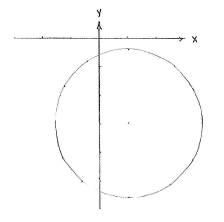Lösung 4.1:7c
Aus Online Mathematik Brückenkurs 1
(Unterschied zwischen Versionen)
K |
K |
||
| Zeile 1: | Zeile 1: | ||
| - | Wir benutzen quadratische Ergänzung | + | Wir benutzen quadratische Ergänzung: |
{{Abgesetzte Formel||<math>\begin{align} | {{Abgesetzte Formel||<math>\begin{align} | ||
| - | x^2 - 2x &= (x-1)^2 - 1^2\,,\\[5pt] | + | x^2 - 2x &= (x-1)^2 - 1^2\,\text{ und},\\[5pt] |
| - | y^2 + 6y &= (y+3)^2 - 3^2\, | + | y^2 + 6y &= (y+3)^2 - 3^2\,. |
\end{align}</math>}} | \end{align}</math>}} | ||
| - | + | Damit erhalten wir die Gleichung | |
{{Abgesetzte Formel||<math>\begin{align} | {{Abgesetzte Formel||<math>\begin{align} | ||
Version vom 13:55, 16. Jun. 2009
Wir benutzen quadratische Ergänzung:
| \displaystyle \begin{align}
x^2 - 2x &= (x-1)^2 - 1^2\,\text{ und},\\[5pt] y^2 + 6y &= (y+3)^2 - 3^2\,. \end{align} |
Damit erhalten wir die Gleichung
| \displaystyle \begin{align}
(x-1)^2 - 1 + (y+3)^2 - 9 &= -3\,,\\[5pt] (x-1)^2 + (y+3)^2 &= 7\,\textrm{.} \end{align} |
Also hat der Kreis den Mittelpunkt (1,-3) und den Radius \displaystyle \sqrt{7}\,.

